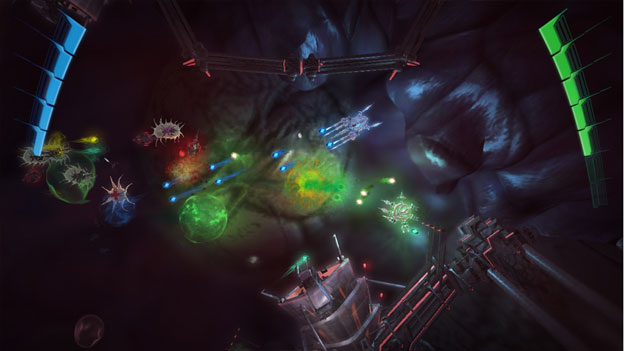Fantastic Voyage?
It’s hard to get pitched a story about tiny autonomous lifeforms being injected into a person’s body and not think of the sci-fi classic Fantastic Voyage. Things have changed a lot since 1966, though, and instead of human beings in a submarine, MicroBot modernizes the scenario to include nanotechnology. The premise, of which you’ll get nothing of when you’re actually playing the game, involves science finally becoming advanced enough that diseases can be treated by injecting AI-driven nanomachines directly into the body of a patient stricken with various illnesses. Unfortunately, though, the first-generation nanorobots soon bond with infected cells, threatening a molecular biotech takeover of the infirmed.

That’s where you come in. Piloting a second-gen nanocraft (the eponymous MicroBot) which initially resembles a mechanized sperm with front arms, it’s your job to make your way through the blood stream, lungs, and other areas of the body where the victim’s immune system is desperately trying to stave off infection. Gameplay, however, is mostly what you would expect from a dual-stick shooter. The MicroBot’s design is outfitted, at least at first, with two front-bearing arms and a tail, on to which you can attach standard weapon augmentations such as burst fire, homing missiles, or mines. The nanomachine’s tail guides propulsion through the murky depths of the human body, and similarly has its own assortment of attachments that will assist in making your swimming more precision-based.
Being able to swim on course and accurately is important, and many of the channels you’ll be navigating here can be tricky, with their own currents and countercurrents. Infected nanomachine replicators, organically bonded to bodily tissue, create new infected cells, and often spew out streams of plasma or other liquid like deep-sea vents, sending your tiny craft flying. Later, clusters of virus particles hurdle quickly through open passages in the lungs, creating hazards not unlike those of an asteroid field. By the time you reach the brain, the nanomachines’ vial infestation has set up microscopic lasers, some of which you have to swim against the current to avoid getting fried.

It’s a major treat to take in MicroBot’s stylized interpretation of the human body—even if most of us will be almost entirely unaware of what we’re looking at most of the time. The game’s depiction of cellular biology is just so much organic window dressing to the actual gameplay, but it’s still pretty interesting to, say, float through the blood stream surrounded by a torrent of red blood cells. Like the warped perspective used to capture the arachnids’ POV in Deadly Creatures, the body here is an alien world, one that’s altogether unrecognizable at times. But MicroBot’s world is no less striking for its deft use of color and lighting, both of which become more advanced and pronounced as the game goes on. A particular treat is watching the fluid reaction of your bullets tearing through the streams on the aforementioned “vents,” or when the screen is suddenly doused in murky color, like the ink from an octopus unfurling into the ocean. Needless to say, you can expect the typical EA level production values here.
Thankfully, enemy encounters ramp up in numbers (if not complexity) as you progress. Each area of the body is made up of four stages, at which point you’ll encounter a larger, more complex boss machine. Defeating these buggers can be tricky at times, but in doing so you sometimes are rewarded with upgrades that increase the number of arms, and thus attachments, your bot has. (Think Gradius’ Vic Viper crossed with a starfish or cephalopod.) Not only does this produce a great aesthetic effect—the MicroBot’s arms work both as guns and fins, and fan out or contract, reacting organically depending on your actions—but it soon becomes invaluable to the more powerful hordes of infected eukaryotes you find in the latter parts of the game.

The combat sometimes requires a little strategy, too. Aside from your typical assortment of direct damage weapons, you’re given auxiliary items, like a rocket booster for quick escape from viral swarms, or the cellular-level equivalent of a nuke. You can also gain new attachments by picking up data pads, which unlock the ability to use such items. Finally, gathering atoms dropped by enemies or in scattered incubation sacs allow you to upgrade your various parts at upgrade terminals, allowing you to pick and choose combinations of offensive, defensive, and support capabilities to your specifications.

If there’s one disappointment in MicroBot (aside from the name), it’s that it doesn’t always do enough with its source material. It’s slightly problematic, if not a huge deal, that the story is non-existent outside of press releases (at least insofar as you never really know where you are and what anything around you is), and although you’re traveling through the human body, rarely do you come across anything that feels like a setpiece—like having to navigate through the heart, as in Fantastic Voyage, or even just shaking up the level design so that you’re not just floating through body-themed passages killing any virus or infected cell you come across. Ideas like companion white blood cells, which will attack you if you attack but will become allies if they see you killing bacteria, are underused, though at least you can play co-op with a buddy, should you desire.
But the most disappointing aspect of a game like MicroBot is the way that it glosses over its scientific essence. While it’s clear that education is not a key factor in an arcade shooter, it would have been really cool if they had included an optional “enhanced” mode, like on a blu-ray that pointed out various information about the microbiology that populates the game. Endless Ocean did that, and was a much better game for it, and it’s a shame not to capitalize on that scientific knowledge—especially for those of us who didn’t major in Biology.
On the other hand, if you just want a game that lets you blast eukaryotes, MicroBot has you covered.
RATING OUT OF 5 RATING DESCRIPTION 4.0 Graphics
MicroBot’s graphics aren’t jaw-dropping, but for a downloadable title, it has some pretty neat effects. 3.3 Control
Having to navigate against bodily currents is sometimes tricky, though the physics effects are pretty impressive. Ease of use can be negotiable. 4.0 Music / Sound FX / Voice Acting
Sound effects are appropriately toned. The ambient, Mass Effect-esque soundtrack can be hypnotic. 3.8 Play Value
MicroBot’s baseline gameplay isn’t revolutionary, but for an arcade shooter, it’s not bad. Might be worth a trip just for the aesthetics, depending on how much like the genre. 3.7 Overall Rating – Good
Not an average. See Rating legend below for a final score breakdown.
| Review Rating Legend | |||
|---|---|---|---|
| 0.1 – 1.9 = Avoid | 2.5 – 2.9 = Average | 3.5 – 3.9 = Good | 4.5 – 4.9 = Must Buy |
| 2.0 – 2.4 = Poor | 3.0 – 3.4 = Fair | 4.0 – 4.4 = Great | 5.0 = The Best |
Game Features:
